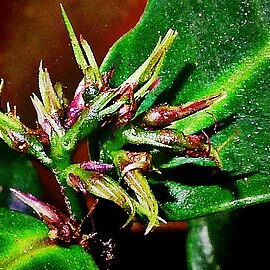Perennial shrubs or subshrubs. Stem erect, subquadrangular, articulated, glabrous to pubescent. Leaves opposite, petiolate; blades usually large, narrowly ovate, membranous, prominently covered with cystoliths. Inflorescences terminal or axillary spikes, solitary to few, often with conspicuous leafy bracts; bracts imbricate, asymmetrical, light green, drying darker green than cauline leaves, entire; bracteoles 2, laterally subtending calyx. Flowers somewhat rare, usually only 1 per spike open at one time, bilipped, homostylous; calyx 5-lobed, lobes subequal, lanceolate, posterior (adaxial) lobe, anterior (abaxial) pair and lateral pair of unequal width; corolla small, straight, tube basally cylindrical, upper half campanulate, limb 2-lipped, personate, usually white or cream-colored, upper lip (posterior) erect, emarginate, lower lip (anterior) erect or ± spreading, 3-lobed, lobes subequal; stamens 4, didynamous, inserted at base or in middle of widest part of tube, united in pairs at base, exserted, anthers of longer pair 2-thecous, thecae superposed or somewhat obliquely attached to connective, those of the shorter pair 1-thecous, all basally obtuse; staminode absent; disk annular; ovary with 2 ovules per locule, style filiform, ending abruptly in a 2-lobed stigma. Capsules, stipitate, acute, retinacula curved; seeds 2-4, lenticular, glabrous.
More
Herbs or shrubs. Inflorescences spikes; bracts loosely imbricate. Flowers with the calyx 5-merous; corolla bilabiate; stamens 4, didynamous, the longer of each pair 2-celled with one of the cells superposed, the shorter of each pair 1-celled. Capsules clavate; seeds 4.

